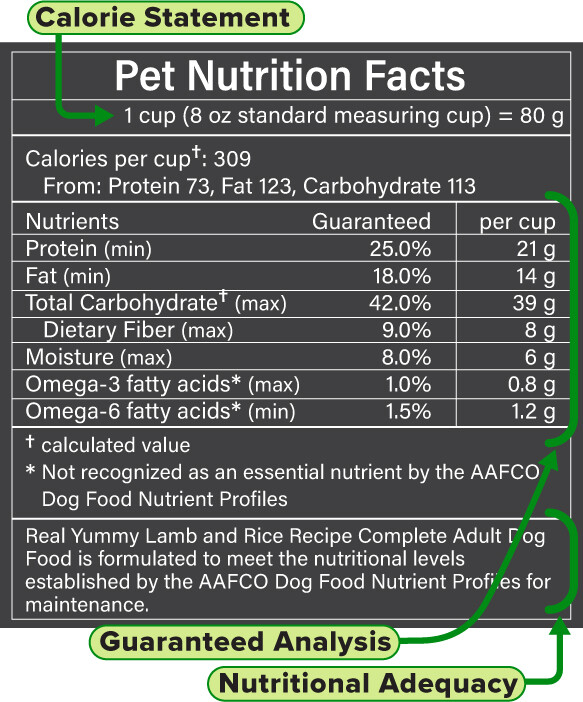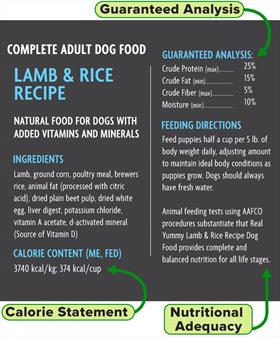 Listen to this story.
Listen to this story.
vns_new_label

Art by AAFCO, Tamara Rees
This is an example of a new pet food nutrition facts box that will be required under updated AAFCO model rules.
Pet food manufacturers and distributors in the United States soon may have to disclose the total carbohydrate and dietary fiber content of their products, as part of a once-in-decades review of pet food labeling rules.
The new model regulations have been approved by members of the Association of American Feed Control Officials (AAFCO), a nonprofit comprised of representatives of state and federal agencies that enforce animal-feed regulations.
AAFCO doesn't have rulemaking or enforcement authority. Rather, it establishes model rules via collaboration among its members, who can choose to adopt them. The new suggested regulations for pet food, approved in July and set to be formalized Jan. 1, mark their first major upgrade in more than 40 years.
Many of the changes are relatively minor. For instance, an intended-use statement — which tells pet owners whether the food offers a complete diet and for which life stage it is appropriate — will now have to be printed on the lower third of the front display panel on the product's packaging. Previously, a consumer would have had to reference a nutritional adequacy statement on the package and, if that was not included, assume that the product was for supplemental feeding only.
"There are more formatting changes than substantive changes," AAFCO Executive Director Austin Therrell said in an interview. "Our goal was not necessarily to create a lot of new information but rather to present it in a way that made it easier for consumers to digest and understand."
Still, Therrell said the requirement to disclose total carbohydrate and dietary fiber concentrations represented substantive changes.
Carbohydrates are a key group of macronutrients found in food for humans and other animals, others being protein and fat. Although carbohydrates are considered to be an essential nutrient for dogs only if they are pregnant or lactating, they still are a useful source of energy. Moreover, many of the carbohydrate sources in pet food, whether they're grains, potatoes or legumes, contain other nutrients such as fatty acids, vitamins and minerals.
vns_old_label

Art by AAFCO, Tamara Rees
This is an example of how nutritional information currently is displayed on pet food.
Carbohydrates in cat food have been more controversial than for dogs, though they are now widely accepted as a healthy ingredient for felines, too. A recent review of the literature published last year in the Journal of the American Veterinary Medical Association said carbohydrates provide cats with energy. The paper also concluded that there is no evidence to suggest that high-carbohydrate diets cause feline diabetes, though it added there is limited evidence that low-carbohydrate diets may help diabetic cats achieve remission.
As for AAFCO's new dietary fiber labeling recommendation, it marks a change from the existing requirement only to disclose "crude fiber" — a calculation method for assessing fiber content that is widely understood to produces less accurate results.
Overall, the changes will bring the labeling of pet food products more in line with food products consumed by humans, which, for example, already are required to have total carbohydrate and dietary fiber content listed on their labels.
"I think consumers and pet owners now are more educated than they've ever been," Therrell said. "And it's AAFCO's role and our responsibility to be a leader in safeguarding animal and human health — so we want to make sure that we're taking these positive steps to update regulations and keep up with trends in the industry."
Asked to elaborate on why the rules are being updated, Therrell said AAFCO periodically evaluates its model language to see if it's keeping up with consumer demand. "When we began the Pet Food Label Modernization project, we were aware of some general feedback from consumers that pet food labeling was difficult to understand," he said. "We wanted to make sure that information presented on the label was clear and easy to understand so that consumers could make better purchasing decisions for their animals."
Adjusting to the new regulations might not be particularly difficult for many product manufacturers, since they likely already have data about carbohydrates and dietary fiber from their own quality control testing or product formulation practices, Therrell said. Still, he confirmed that AAFCO has recommended that states allow a six-year discretion period, commencing from Jan. 1, when AAFCO publishes its Official Publication for 2024, before enforcing any new rules.
After the leniency period ends, manufacturers breaching the labeling regulations could face actions ranging from warning letters to sale embargoes.
Veterinarians ultimately will benefit from more transparent information, Therrell maintains. "It's going to give them a better overall picture of the nutritional profile of products. And it's going to make it easier for veterinarians to recommend products to clients that have the right intended use, for the right life stage of their pet."